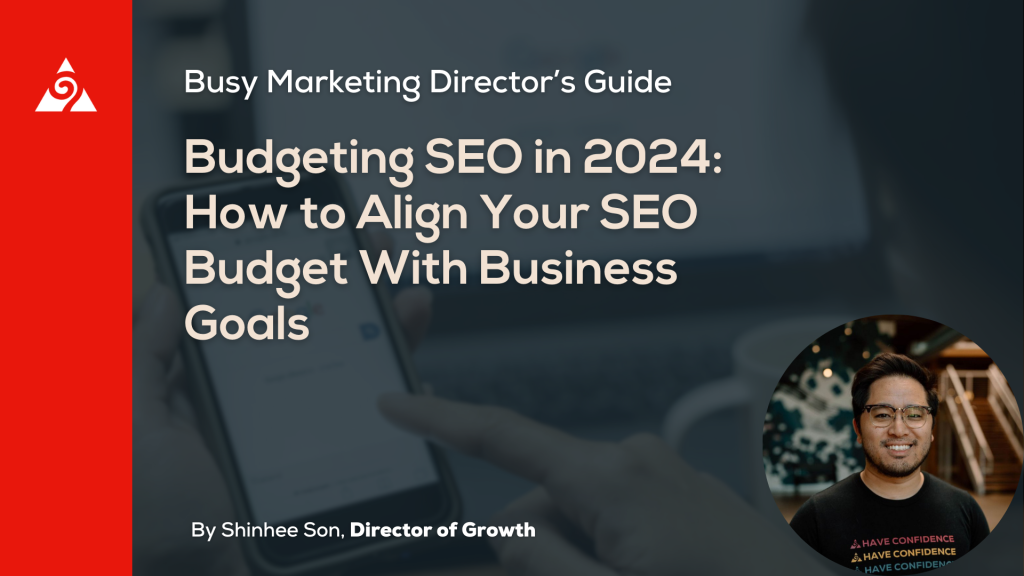Facing increasing pressure to demonstrate SEO’s ROI, many marketing directors are navigating tighter budgets and higher expectations. As a marketing director, you’ve got a lot on your plate—managing your team, executing your marketing plan, and justifying every dollar spent. It can feel overwhelming, especially with all the buzz about SEO’s uncertain future.
But here’s the good news: despite all the headlines about SEO shifting or declining, we’re still seeing a lot of success for companies that stay focused and invest wisely. SEO is far from dead—it just requires a smarter approach. This guide will help you structure your SEO budget in 2024 so it aligns with your business goals and delivers results your leadership will notice.
Whether you’re doing SEO in-house or with an agency, we’ll walk you through where to spend, what to prioritize, and how to show the value of SEO. Let’s take the stress out of budgeting and build a plan that works.
Understanding the Importance of SEO Budgeting
Why SEO is crucial for your marketing budget
SEO budgeting is essential for any business looking to establish a strong online presence and drive revenue through search engine optimization (SEO). A well-planned SEO budget helps allocate resources effectively, ensuring your marketing efforts focus on achieving specific goals and objectives. Investing in SEO can increase your website’s visibility, drive organic traffic, and ultimately boost your bottom line.
In today’s digital landscape, search engines are often the primary source of website traffic. Organic search remains a critical channel for acquiring and retaining new customers. Unlike paid advertising, which requires continuous investment, SEO provides long-term benefits by improving your site’s authority and relevance. This makes SEO a cost-effective strategy within your overall marketing budget, delivering sustainable growth over time.
Determine your business goals and objectives
Before creating an SEO budget, it’s crucial to determine your business goals and objectives. What do you want to achieve through SEO? Are you looking to increase website traffic, generate leads, or drive sales? By setting clear goals, you can create a tailored SEO strategy that aligns with your business objectives and ensures a strong return on investment (ROI).
For instance, if your primary goal is to increase website traffic, your SEO strategy might focus on content creation and keyword optimization. If lead generation is your priority, you might invest more in optimizing landing pages and improving user experience. By clearly defining your goals, you can allocate your SEO budget to the areas that will significantly impact your business.
1. Understand the Total SEO Budgeting Available
Start by getting a clear view of the total marketing budget allocated for the year. From there, confirm how much is assigned to SEO marketing or your overall digital marketing efforts. You might be working with a fixed number, or there could be flexibility depending on how leadership perceives SEO’s importance.
Next, assess the performance of other channels—like paid search, email, and social media—and determine what percentage of the budget can realistically go to SEO. If SEO has been delivering strong ROI, you may be able to argue for a larger share. However, if SEO is competing with other high-priority efforts, you’ll need to advocate for why SEO deserves its place in the mix. Be ready to justify how SEO contributes to long-term growth while delivering short-term wins.
Actionable Tip: When negotiating your budget, highlight SEO’s cost-effectiveness in driving organic traffic compared to paid channels. Use past performance data, such as cost-per-lead comparisons, to make a stronger case.
2. Assessing Your Current SEO Situation
Evaluate your cumulative SEO results
Evaluating your cumulative SEO results is essential to creating an effective SEO budget. This involves analyzing your website’s current performance, including metrics such as organic traffic, keyword rankings, and conversion rates. By understanding your current SEO situation, you can identify areas for improvement and allocate your budget accordingly. This may involve investing in SEO services such as keyword research, on-page optimization, link building, and content creation to enhance your website’s visibility and drive more traffic.
Assessing your current SEO situation can also help you identify opportunities to optimize your existing digital marketing budget. This may involve reallocating resources from other marketing channels, such as paid advertising, to SEO or investing in SEO tools and software to streamline your marketing efforts. By taking a holistic approach to SEO budgeting, you can ensure that your marketing spend is aligned with your business goals and objectives and that you’re getting the most out of your SEO investment.
Regularly conducting an SEO audit can provide valuable insights into your website’s performance and highlight areas that need attention. This proactive approach allows you to stay ahead of the competition and adapt your strategy based on real-time data. By continuously monitoring and adjusting your SEO efforts, you can maximize the effectiveness of your budget and achieve sustainable growth.
3. Break Down SEO Strategy into Core Activities
SEO isn’t a one-size-fits-all activity; your budget should reflect its different components. Breaking SEO down into its core activities will help you allocate resources effectively:
- Technical SEO: Invest in site audits to identify and fix issues like crawl errors, broken links, and slow page speeds. This foundational work ensures that your site can be properly indexed by search engines.
- Content Creation/Optimization: Allocate budget for creating new content targeting high-value keywords and optimizing existing content. This drives both traffic and engagement.
- Link Building/Authority Building: Build high-quality backlinks to improve your domain authority. Remember, not all backlinks are created equal—quality over quantity is key.
- Tools and Software: You’ll need tools to track rankings, monitor site health, and analyze keywords. Popular tools like Ahrefs and SEMrush are essential, but also budget for any specialized tools needed for your SEO strategy.
- Reporting/Analytics: Ensure you’re set up to track the impact of your SEO efforts, whether through in-house dashboards or outsourced reporting tools.
For a deeper dive into these core SEO processes and how they fit into your overall strategy, I’ve discussed them in more detail here.
Actionable Tip: Prioritize activities based on where you expect the most significant impact. For example, if your site has major technical issues, technical SEO might be your highest priority.
4. Estimate SEO Costs for Each Component
Once you’ve broken down SEO into core activities, you must assign realistic cost estimates to each. Here’s a general guide:
- Technical SEO: Expect to spend $500–$2,500 for a one-time audit, plus additional developer costs for implementation. Developer rates can range from $50–$150 per hour, depending on the complexity of the fixes.
- Content Creation/Optimization: Freelancers charge $100–$500 per new content piece, while updates to existing content typically cost less. If your team handles content creation, account for their time.
- Link Building: Link-building agencies may cost between $500 and $5,000 per month. Alternatively, manual outreach in-house requires time or a dedicated freelancer.
- SEO Tools: Budget $100–$500 monthly for tools like Ahrefs or SEMrush. Google Search Console is free but limited so you may need a paid option for in-depth analysis.
- Reporting/Analytics: SEO professionals can help evaluate your current performance and customize strategies. If outsourcing reporting, account for additional costs or ensure your team has time allocated for data analysis and dashboard creation.
Actionable Tip: Compare vendor quotes or rates with your team’s bandwidth. If your team can handle some tasks (e.g., content updates), allocate more of your budget to areas that require external expertise, like technical fixes or link-building.
5. Align SEO Investment with Business Goals
To justify the budget, tie your SEO efforts directly to your company’s business goals. Leadership will be more inclined to support your budget if they see how SEO aligns with top priorities.
- Traffic & Rankings: If leadership is focused on increasing website traffic, prioritize content creation and link-building efforts to target high-value keywords.
- Lead Generation: To drive conversions, focus on optimizing product/service pages with strong calls-to-action and high-ranking keywords.
- Brand Awareness: If brand visibility is the main goal, invest more in content marketing and building authority through guest posts and backlinks.
Actionable Tip: When presenting your SEO strategy, frame it in terms of its direct contribution to business KPIs, such as increasing revenue, generating leads, or improving brand awareness.
6. Allocate Budget Based on Prioritization
Once you have cost estimates, prioritize SEO activities based on potential ROI and consider seo pricing models to allocate your budget effectively. This will help you make the most of your available budget.
- High Impact/Low Cost: Focus first on technical SEO and content optimizations, which tend to offer quick wins at a lower cost.
- Strategic Investments: Allocate more budget to long-term efforts like link-building or developing pillar content, which take longer to see results but can yield significant returns over time.
- Cut Low-Value Initiatives: Avoid spending on efforts that don’t directly contribute to business goals, like ranking for irrelevant keywords or low-quality link-building.
Actionable Tip: When prioritizing, focus on activities that have a clear, measurable impact on revenue or key business metrics. This will make it easier to demonstrate ROI to leadership.
7. Create a Monthly SEO Budget Plan with Built-in Flexibility
Instead of allocating your entire SEO budget upfront, break it down into monthly or quarterly phases. This allows you to remain flexible and adapt to changes in performance, priorities, or unexpected challenges. Here’s a phased approach to planning your SEO budget:
- Months 1–3: Focus on technical SEO fixes and content audits to build a solid foundation for future efforts.
- Months 4–6: Shift towards new content creation and link-building to increase visibility and improve rankings.
- Months 7–12: Continue optimizing content, refining link-building strategies, and adjusting based on performance data.
To further ensure flexibility, set aside 10-20% of your SEO budget to handle unforeseen opportunities or challenges:
- Sudden Opportunities: For instance, if a trending topic related to your industry emerges, quickly create content to capitalize on the traffic surge.
- Algorithm Changes: If an algorithm update impacts your rankings, use this budget to address necessary technical fixes or content adjustments.
Actionable Tip: Conduct rolling reviews every three months to assess if your SEO investments are delivering results and adjust your budget allocation as needed. Stay informed about industry changes to ensure your strategy remains effective.
8. Track Performance and Adjust
Set clear KPIs (like organic traffic, keyword rankings, or conversions) to measure the success of your SEO efforts. Track performance regularly and adjust your budget allocation based on what’s working.
- Content: If the content is driving traffic or conversions, allocate more resources to creating and optimizing new pieces.
- Link Building: If link-building efforts are improving rankings for high-value keywords, consider increasing your outreach budget.
- Cut Back: On the other hand, if certain efforts aren’t delivering results, be prepared to cut back and redirect resources to more effective tactics.
Actionable Tip: Use reporting tools to create easy-to-understand dashboards for leadership, showing how SEO contributes to the bottom line. This will help justify future budget requests.
Example SEO Budget Allocation:
Let’s say you have $50,000 annually allocated to SEO. Here’s how a basic breakdown might look:
- Technical SEO (10-15%): $5,000 – $7,500
- Content Creation/Optimization (40-50%): $20,000 – $25,000
- Link Building (20-25%): $10,000 – $12,500
- SEO Tools (10-15%): $5,000 – $7,500
- Reporting/Analytics (5-10%): $2,500 – $5,000
This approach balances technical fixes with ongoing content production, link-building, and the tools/reporting needed to ensure a successful SEO strategy.
Conclusion
With a clear plan, you can confidently align your SEO efforts with your business goals and show leadership the value it brings.
Remember, SEO is a long-term game. While quick wins are great, the real value comes from consistent, strategic investment. Keep your budget flexible for unexpected changes, and regularly track your performance to ensure you’re on the right path.
By following this approach, you’ll hit your SEO targets and build a case for how SEO contributes to the bigger picture. You’ll be able to show leadership that your efforts are driving real, measurable results and helping the company succeed in 2024 and beyond.
Here’s a quick recap of the key steps to align your SEO budget with your business goals in 2024:
- Understand Your Total SEO Budget: Confirm how much is allocated for SEO within your overall marketing budget.
- Assess Current SEO Performance: Evaluate metrics like organic traffic and keyword rankings to determine where improvements are needed.
- Break Down SEO into Core Activities: Allocate budget for technical SEO, content creation/optimization, link-building, and necessary SEO tools.
- Estimate Costs for Each Component: Assign realistic costs to each activity, ensuring proper resource allocation.
- Align SEO Investment with Business Goals: Tie SEO efforts directly to business objectives, like driving traffic, generating leads, or increasing brand awareness.
- Prioritize Spending Based on ROI: First, focus on high-impact, low-cost activities, and then allocate more to strategic investments over time.
- Create a Monthly Budget Plan with Flexibility: Break down the SEO budget into phases and set aside 10-20% for unexpected challenges or opportunities.
- Track Performance and Adjust: Regularly review KPIs and reallocate resources to top-performing SEO efforts.
By following these steps, you’ll ensure your SEO strategy is aligned with business objectives and delivers measurable results that leadership will notice in 2024.
Need help optimizing your SEO strategy? Request an SEO audit to identify opportunities, uncover gaps, and build a plan tailored to your goals. Learn more and get started here.
- Budgeting Content Marketing in 2024: How to Align Your Content Budget With Business Goals - September 9, 2024
- Budgeting Paid Media in 2024: How to Align Your Paid Media Budget With Business Goals - September 9, 2024
- Budgeting SEO in 2024: How to Align Your SEO Budget With Business Goals - September 9, 2024





